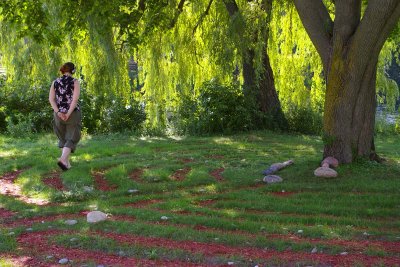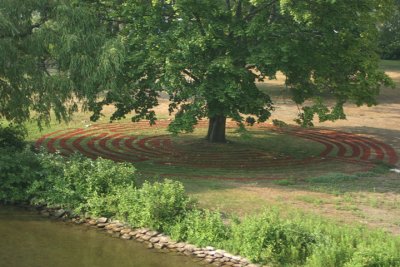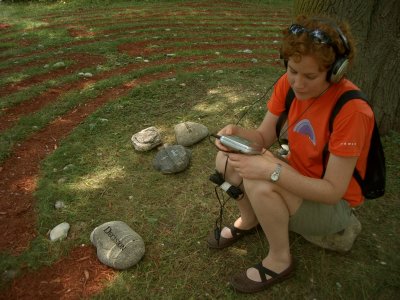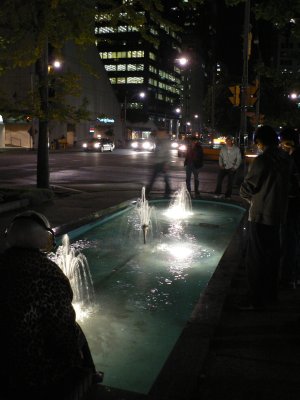Reciprocal Listening in Electroacoustic Sound Installation
Reciprocal listening in electroacoustic sound installation — what does that mean? Reciprocal listening is a phrase recently coined by Gayle Young (editor of Musicworks magazine) while she was interviewing me for an article. It comes from my newfound belief that the listener can play an active role in divining the meaning and intent of a work. I came upon this idea while considering the classical music concert experience in the context of current North American culture.
The classical concert experience, after centuries of refinement, is defined, for the most part, by its incredible ability to separate the music from the soundscape, to attempt to limit most sensory input with the exception of hearing. Although this living museum continues to offer incredible musical potential, there are informed and eager listeners who have little desire to listen in this format, and whose experience with organized sound is solely schizophonic, that is, by hearing most of their music divorced from its original sound source, either over loudspeakers or earphones. With this realization came a need, on my part, to explore how I was communicating, to consider somatic, visual, and schizophonic elements in my work; and with this exploration came my sound installations.
This heightened interest in communication and interaction with the listener has led me to think deeply about the act of listening and the perception of organized sound. As in everything else, there is only one first impression of a piece of music. I believe we can only be uniquely surprised and uniquely process the meaning of what we are hearing on the first listen. With each subsequent listening the intellect and the ear interpret and understand the work from a place of personal assimilation. In my latest works I have been exploring this; what role can the listener play in divining the meaning of the work? Can a piece of music be a dialogue between the composer and the listener?
I would like to discuss how my latest work — the sound installations Wandering Sacred and Unearthed — use location, physical movement and electroacoustics to explore these questions.
Wandering Sacred

In the summer of 2005 I had the opportunity to write a piece that addressed my desire to move my work out of the concert hall and to explore listening and meaning with the audience. New Adventures in Sound Art commissioned me to create a piece for their Sign Waves series on Toronto Island with the support of the Laidlaw foundation and the Canadian Music Centre’s New Music In New Places program. Wandering Sacred is a site-specific sound installation for labyrinth and headphones. The participant moves through a labyrinth while listening to the electroacoustic element over headphones.
The location and the concept of the piece came together at the same time. I had been reflecting for some time on what appeared to be the ever-emerging sacred status of personal happiness in contemporary society. The unending quest of North Americans to control their psyches and anticipate possible regret. And I had begun to wonder: Is our happiness definable, knowable, static? Is it within reach? And what is to be said of the journey toward happiness?
The Sign Waves series is held at St. Andrew-by-the-lake church on Centre Island, adjacent to a children’s amusement park. And when I saw this location I thought, “what better place than between a church and an amusement park was there to reflect on the sacred status of happiness?”

In addition to the church and the amusement park, outside the church is a Chartres design walking turf labyrinth, built by Toronto artist Laurie Jones. I had been aware of walking labyrinths and their use in meditation practice since my time in California. The labyrinth combines the imagery of both the circle and the spiral to create a circuitous but directional path. A labyrinth has only one route. Unlike a maze, it is not a puzzle with blind alleys and wrong turns. It is unicursal: the way in is the way out.
The labyrinth is divided into four quadrants in which the walker meanders through each of the four quadrants several times — sometimes close to the centre, sometimes far — before reaching the centre. This archetypal symbol has a long history, it was present in Greek Mythology in addition it was used prevalently in medieval Christian practice and presently it is used as a spiritual and psychological meditation aid. The meandering nature of this labyrinth, mirrors the shifting points of view that occur during a psychological journey. In this way, the labyrinth lends itself to the concept of the piece, a metaphoric journey towards happiness.
The location and the concept of the piece addressed my need for somatic and visual, elements but how was I going to further engage the participant into creating the meaning of the piece? I needed an aural catalyst. This is where the electroacoustic element comes into play.
The electroacoustic portion of the installation is played over individual headphone sets in this outdoor setting, and has two elements: soundscape and text. The location has a very rich outdoor soundscape, with water, wildlife, and human sound. This soundscape was recorded via a Neumann shotgun mic and the Sound Devices 244 portable digital recorder and then recreated electronically.
By displacing the soundscape schizophonically from the outdoor setting to headphones, the participant is encouraged to question their perception. For example this aural cue of a child running makes sense in the context of seeing the amusement park, but there was no matching visual cue. What is real and what is an illusion?
In addition to the soundscape, I chose to use English text in the electroacoustic part. Text has limitless potential for nuance, connotation and meaning and by exploring syntax, content, and tone I was able to encourage the participant to contribute to the meaning of the piece.

For the text component, I interviewed twenty-one women and children about motherhood and childlessness. Then, through editing, the entire subject matter was removed. Nowhere was motherhood or childhood mentioned in the piece.
The parsed phrases were then analyzed for the tone and texture of the voices. For example, amplitude, texture of the voice — physical attributes like density of tone, frequency, timbre, accent, etc.
Once the phrases were edited and categorized they were arranged into a dramatic structure. For example, exposition, climax and denouement with transitions. The exposition contained phrases that had anticipatory forward-looking content and was structured to include calm voices in a sparse texture.
The climax, if you will, contains phrases that implied uncertainty and conflict, and was structured for density of aural events and clouding of word intelligibility.
The last section is the denouement of the narrative and includes phrases that have a tone of resignation or resolution and repetition.
This brings me back to my original question of reciprocal listening: if the subject matter is removed from the narrative, and the soundscape is processed to heighten specific psychoacoustic reactions, what meaning will the listener ascribe to the piece? What story will they build? Wandering Sacred has a specific meaning for me as a composer: my personal journey toward childlessness. What interests me is the space between the meaning of the piece for myself as the composer and the perceived meaning of the piece for the listener. Wandering Sacred mediates the exchange, to involve the listener until the listener becomes a participant. As I had hoped, the interpretation of the piece varied with each listener. Some felt it was an environmental statement, others a statement on organized religion. One participant, a dancer I think, interacted very physically with the space while listening to the sound. In the centre of the labyrinth, I had placed five small boulders, engraved with key words from the piece as touchstones to the narrative. The dancer stood on the “decision” rock and was rocking it back and forth under her feet. So her reaction to it was very physical. Other people were very emotional after the experience. So the reactions to the piece varied greatly according to what each listener brought to the work.
Unearthed
Unearthed is a binaural audio walk written in the summer of 2006, and is another piece in which I explore the listener as participant by using location, physical movement, text and soundscape. The piece was written for Toronto’s Nuit Blanche festival with support from the New Music in New Places program and New Adventures in Sound Art. The piece plays over headphones while narrative clues direct the participant on foot over the traffic medians of Toronto’s University Avenue.
In this piece the location is everything, it informs the materials, the method, the subtext and the structure of the piece. And it is the participant’s experience and reactions to these elements that engages them as physical and cognitive participants. First let me describe the location in detail. The site of Unearthed is University Avenue, an eight-lane traffic corridor. In the centre of the avenue is a large landscaped median resplendent with monuments, trees, gardens, and fountains. These oases of water and landscape could be interpreted as a subconscious nod to Taddle Creek, a river buried beneath the street. This creek originally ran above ground to Lake Ontario, was buried underground in a brick lined riverbank during the mid 19th century for reasons of urban planning. To this very day — not very far from where we are right now [the Faculty of Music at the University of Toronto] — it still flows underground into the lake.
This is a very dichotomous location. As one walks up the median, one moves from an urban soundscape with traffic, people and street life to areas of dense vegetative landscape where one is hidden from the traffic by trees, gardens and fountains.

It is this dichotomy that led me to the several subtexts of Unearthed. The meanings and implications of the following dualities are explored: past and present, reality and fantasy, what is seen and what is hidden.
Like Wandering Sacred, Unearthed’s materials have two elements: soundscape and text. The content of the materials mimic the location’s duality. For the urban soundscape, binaural recordings were made on the median using Soundman OKM Binaural ear mics, (courtesy of Darren Copeland), and a Sony mini-disc recorder. Care was taken to position and move the mics over the median in the same way the participant would be walking. This produced a hyper-reality for the participants since they couldn’t tell which sounds come from the street and which sounds came from the headphones. For example, they would hear a motorcycle turning in front of them and look to see no motorcycle. Again, by displacing the soundscape schizophonically from the outdoor setting to headphones, the participant is encouraged to question their perception.
Linked to the urban soundscape is the following text.
Unearthed text, part one
It’s starting again
somewhere between here and the surrendered sea
the silver trickle flow
surfaces.I buried you
and willing you sunk to the sea
surrendered to the earth that leaves you hidden.It’s not time
time yet to unearth
unearth our secrets.So surrender silver trickle
flow still in memory
safely underground.
Note that there are no specifics in the text. The text speaks of burying/unearthing, of will and surrender and of secrets. There is no concrete narrative and the words were chosen for their potential for nuance, connotation and meaning. In this way the text leaves room for the participant to ascribe their own personal meaning to the piece.
The second part of audio part accompanies the pseudo-rural locations on the median. Because the attendant soundscape for this location was masked by the sound of traffic, I needed to supply an imaginary soundscape — a soundscape that may have been present when Taddle creek was above ground and this area was truly a rural landscape. This imagined soundscape was recorded at the Luther Marsh conservation area — 100 kilometres north of Toronto, using the binaural setup and a Neumann shotgun mic with the Sound Devices 244 portable digital recorder. Birds, bugs, a flowing creek and footsteps were recorded and arranged to accompany the participants’ journey through the medians. The schizophonic nature of the binaural recordings in Unearthed is most strong in these sections. The rural natural soundscape is placed into the middle of the city. This leads the participant to once again question their perception.
Now that I had the soundscape to mimic the landscape, I needed a way to move the participants up and down the median. Unlike, Wandering Sacred’s labyrinth there was no set route for the participants. I found the solution by adding a second narrative to accompany the pseudo-rural locations on the median. The narrative in this section includes key instructions and the sound of footsteps so the participant can pace their walking to the piece.
Unearthed text, part two
Hello, thank you for meeting me here. |
And Muddy York swallows traitors deep in the mud. Now I am to blame. For many things Blood, treason and king, It is very bitter but I shall not abandon hope For I can indeed say The Earth is not to be trifled with He who controls the land controls destiny On these nights when I cannot sleep and there is nothing but time, If fighting for the claim of land is errant, then let them deem me wrong I know in my thoughts, words, deeds that time will prove me true They say if you tell the creek your sins it will wash them to the lake, and bring them back to mark me forever. How shall I bear it? I think it would be better to live without memory For the chance of a tomorrow Than a life guided by moonlight. You must stop here and I will take my leave, I cannot say how I will fare underground, lost to memory But I do not fear, Comforted as I am by your promise to keep my secrets. |
The text as seen here give key directions to the participants, for example, “come sit with me,” and “it is time to retrace our steps.” You will notice that the content of the narrative is very vague, the narrator speaks of danger, secrets, treachery, a text that any of the participants could interpret from their own experience.
Again, as I had hoped in Wandering Sacred, people brought their own experiences to the listening of this piece. Some thought it was an environmental statement, others thought it was a tribute to our war veterans, others just reveled in the binaural spectacle of it all. This is so fulfilling, it’s a place where the dialogue can begin.
Audience reaction, Gayle Young:Given headphones and a CD player on a crowded city street at night, you are asked to follow the directions provided in the audio. You hear sharp footsteps moving towards you from your left, from the busy roadway, whose traffic sounds would prevent such footsteps from being heard: that sound, then, must be on the recording. You can’t tell, really, which sounds come from the street and which from the headphones. A woman’s voice directs you to walk north, to cross the road: that voice as well must be on the CD. And as you walk, another voice joins hers. They speak of burial, and you hear the sounds of a stream, of summer birds and frogs. As you near the next intersection, you again hear streetcars and other traffic sounds, and you are drawn from fantasy to reality, from past to present. The voices speak of danger, of escape, of surrender. They are themselves the buried memories of a past and a present, in the imagined soundscapes of two women, one of them an emissary whose intrigues led to the failure of a popular uprising against the British, and the other an old woman reflecting on her past. Their voices form a chorus with the sounds of the still-flowing stream that lies buried in underground culverts below the paved street. And once again real sound and imagined sound mix, and reality and memory collide.
Acknowledgements
The author would like to thank:
Gayle Young for the interview which caused me to articulate these thoughts.
Photographers Stefan Rose, Jessica Dzupina, Ryan Scott, and Eric Ross for use of their photographs.
Laurie Jones for her labyrinth solvitur ambulando.
The presenters of the works: New Adventures in Sound Art, Darren Copeland and Nadine Thériault-Copeland. Jessica Rose, curator of My Secret City for the City of Toronto and Scotiabank Nuit Blanche.
The funders of the works: Craig Smibert, Laidlaw Foundation, New Music in New Places of the Canadian Music Centre who gratefully acknowledges the support of the SOCAN foundation and the Government of Canada through the Canada Music Fund, Smith Monument Co. Ltd., for Wandering Sacred. And Craig Smibert, New Adventures in Sound Art, New Music in New Places program of the Canadian Music Centre who gratefully acknowledges the support of the SOCAN foundation and the Government of Canada through the Canada Music Fund, City of Toronto through its Live with Culture fund for Unearthed.
Social top